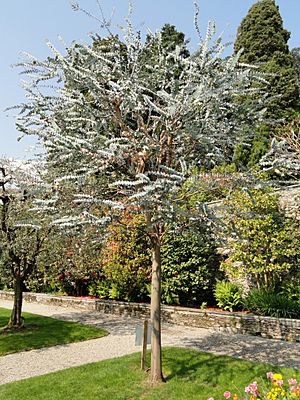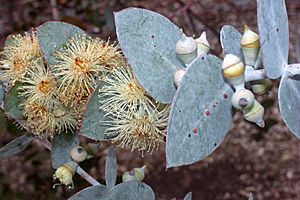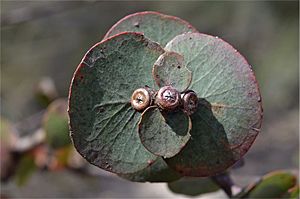Silver-leaved mountain gum facts for kids
Quick facts for kids Silver-leaved mountain gum |
|
|---|---|
 |
|
| cultivated specimen of E. pulverulenta in Italy | |
| Conservation status | |
| Scientific classification | |
| Genus: |
Eucalyptus
|
| Species: |
pulverulenta
|
| Synonyms | |
|
|
The Eucalyptus pulverulenta, often called the silver-leaved mountain gum, is a special type of tree or shrub. It grows naturally only in southern New South Wales, Australia. This plant has smooth bark and unique leaves that are shaped like eggs, hearts, or circles. Its leaves grow in pairs directly on the stem. The tree produces flower buds in groups of three, which open into white flowers. Later, these flowers turn into cup-shaped or cylinder-shaped fruits.
Contents
What is the Silver-leaved Mountain Gum?
The silver-leaved mountain gum can be a small, straggly tree, usually growing up to 5 meters (about 16 feet) tall. Sometimes, it can grow into a larger tree, reaching up to 9 meters (about 30 feet). This plant also has a special woody swelling at its base called a lignotuber. This helps the tree regrow if it gets damaged, for example, by fire.
Its bark is smooth and can be greenish, grey, or brown. Sometimes, the bark peels off in short ribbons. The top part of the tree, called the crown, mostly has young leaves. These leaves are egg-shaped, round, or heart-shaped. They are also glaucous, which means they have a dull, waxy, bluish-green coating, like a fine powder. The leaves are 15-50 mm long and 20-50 mm wide, and they grow in opposite pairs directly on the stem without a stalk.
How to Spot a Silver-leaved Mountain Gum
The flower buds of this eucalyptus grow in groups of three. They are found where the leaves meet the stem. Each group of three buds sits on a short stalk, called a peduncle, which is 3-12 mm long. The individual buds might be directly attached or have very short stalks, called pedicels, up to 3 mm long.
When the buds are ready to open, they are also glaucous and look like ovals or diamonds. They are about 9-11 mm long and 4-7 mm wide. Each bud has a cap, called an operculum, which can be cone-shaped or have a beak-like tip.
The silver-leaved mountain gum flowers from May to November, and its flowers are white. After flowering, the tree produces woody fruits. These fruits are shaped like cups or cylinders, about 5-10 mm long and 6-11 mm wide. Inside, they have valves (parts that open) that are close to the rim.
Why is it Special? (Its Name and Discovery)
The scientific name for this tree, Eucalyptus pulverulenta, was first officially written down in 1819. This was done by a person named John Sims in a magazine called Botanical Magazine.
The second part of its name, pulverulenta, comes from the Latin word pulveratus. This word means "powdered." It refers to the powdery white coating you can see on the leaves, buds, and fruits of this tree.
Where Does it Live?
The silver-leaved mountain gum is found in only a few scattered places in New South Wales, Australia. These areas are mainly in the Central and Southern Tablelands, between the towns of Bathurst and Bombala. It prefers to grow in grassy woodlands on hillsides and mountains.
Is it in Danger? (Conservation Status)
This type of eucalyptus tree is considered "vulnerable" by the Australian Government. This means it is at risk of becoming extinct if we don't protect it. In 1990, there were only about 5,400 of these plants known, spread across ten different groups.
The main things that threaten the silver-leaved mountain gum are:
- Damage to its natural home from animals grazing.
- Areas being cleared for things like fire trails.
- The fact that there are only a small number of these plants left in the wild.




